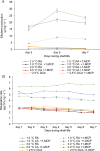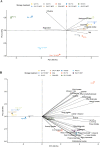Impact of different storage conditions with combined use of ethylene blocker on 'Shalimar' apple variety
- PMID: 38605100
- PMCID: PMC11009402
- DOI: 10.1038/s41598-024-57688-6
Impact of different storage conditions with combined use of ethylene blocker on 'Shalimar' apple variety
Abstract
This research investigates the impact of storage conditions on the quality and preservation of 'Shalimar' apples, a relatively new cultivar known for its resistance to apple scab and powdery mildew. The study explores the efficacy of different storage techniques such as regular atmosphere (RA), controlled atmosphere (CA), and dynamic controlled atmosphere with CO2 Monitoring (DCA-CD), as well as the integration of 1-methylcyclopropene (1-MCP) at different storage temperatures (1 °C and 3 °C). Various fruit quality parameters were monitored under different storage conditions, including firmness, titratable acidity, total soluble solids, background color, respiration, ethylene production, and volatile compounds. The results indicate that the controlled atmosphere (CA) at 1 °C emerges as an efficient method for long-term storage. However, it is noted that CA storage may impact the apple aroma, emphasizing the need for a balance between preservation and consumer acceptability. On the other hand, DCA-CD at variable temperatures (approximately 2.5 °C) offers a promising approach for maintaining fruit quality and a higher concentration of volatile compounds. Integrating 1-MCP enhances firmness, but its impact varies across storage conditions. Principal component analysis (PCA) provides insights into the relationships between storage conditions, fruit quality, and volatile compounds. This study contributes valuable insights into optimizing storage strategies for 'Shalimar' apples, addressing sustainability and quality preservation in apple production.
Keywords: Malus domestica Borkh.; 1-methylcyclopropene; Controlled atmosphere; Dynamic control atmosphere; Regular atmosphere; Volatile organic compounds.
© 2024. The Author(s).
Conflict of interest statement
The authors declare no competing interests.
Figures





References
-
- Militaru M, Butac M, Cristian P, Costinel BL, Cosmina S. Influence of storage duration on apple fruit quality. Sci. Pap. Res. Inst. Fruit Grow. 2016;32:86–92.
-
- Lurie S, Watkins CB. Superficial scald, its etiology and control. Postharvest. Biol. Technol. 2012;65:44–60. doi: 10.1016/j.postharvbio.2011.11.001. - DOI
-
- Prange, R. K., Delong, J. M. & Harrison, P. A. Quality Management through Respiration Control: Is there a Relationship between Lowest Acceptable Respiration, Chlorophyll Fluorescence and Cytoplasmic Acidosis? (2005).
-
- Bessemans N, Verboven P, Verlinden BE, Nicolaï BM. Model based leak correction of real-time RQ measurement for dynamic controlled atmosphere storage. Postharvest. Biol. Technol. 2018;136:31–41. doi: 10.1016/j.postharvbio.2017.09.011. - DOI
-
- Gul, K., Mir, N. A., Singh, P. & Wani, A. A. Postharvest biology and technology of apple. In Postharvest Biology and Technology of Temperate Fruits 223–243 (2018) 10.1007/978-3-319-75163-4_9.
MeSH terms
Substances
LinkOut - more resources
Full Text Sources
Miscellaneous

